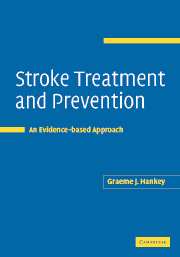Book contents
- Frontmatter
- Contents
- Preface
- 1 The size of the problem of stroke
- 2 Understanding evidence
- 3 Organised acute stroke care
- 4 General supportive acute stroke care
- 5 Reperfusion of ischaemic brain by thrombolysis
- 6 Augmentation of cerebral blood flow: fibrinogen-depleting agents, haemodilution and pentoxifylline
- 7 Neuroprotection
- 8 Treatment of brain oedema
- 9 Anticoagulation
- 10 Antiplatelet therapy
- 11 Carotid artery revascularisation
- 12 Lowering blood pressure
- 13 Lowering blood cholesterol concentrations
- 14 Modification of other vascular risk factors and lifestyle
- 15 Antithrombotic therapy for preventing recurrent cardiogenic embolism
- 16 Arterial dissection and arteritis
- 17 Treatment of intracerebral haemorrhage
- 18 Treatment of subarachnoid haemorrhage
- References
- Index
10 - Antiplatelet therapy
Published online by Cambridge University Press: 23 December 2009
- Frontmatter
- Contents
- Preface
- 1 The size of the problem of stroke
- 2 Understanding evidence
- 3 Organised acute stroke care
- 4 General supportive acute stroke care
- 5 Reperfusion of ischaemic brain by thrombolysis
- 6 Augmentation of cerebral blood flow: fibrinogen-depleting agents, haemodilution and pentoxifylline
- 7 Neuroprotection
- 8 Treatment of brain oedema
- 9 Anticoagulation
- 10 Antiplatelet therapy
- 11 Carotid artery revascularisation
- 12 Lowering blood pressure
- 13 Lowering blood cholesterol concentrations
- 14 Modification of other vascular risk factors and lifestyle
- 15 Antithrombotic therapy for preventing recurrent cardiogenic embolism
- 16 Arterial dissection and arteritis
- 17 Treatment of intracerebral haemorrhage
- 18 Treatment of subarachnoid haemorrhage
- References
- Index
Summary
The purpose of antiplatelet therapy, like that of anticoagulation (Chapter 9), in patients with acute ischaemic stroke or transient ischaemic attack (TIA) is to prevent recurrent ischaemic stroke and other serious vascular events (by preventing arterial thromboembolism and cardiogenic embolism) and to prevent venous thromboembolism.
Acute ischaemic stroke
Antiplatelet therapy vs control
Evidence
A systematic review of randomised trials comparing early antiplatelet therapy (started within 14 days of the stroke) with control in patients with definite or presumed ischaemic stroke identified nine trials involving 41,399 patients (Chen et al., 2000; Sandercock et al., 2003).
Antiplatelet regimens tested
Antiplatelet agents were broadly defined as any agents whose principal effects were to inhibit platelet adhesion and aggregation. These included:
cyclo-oxygenase inhibitors (e.g. acetylsalicylic acid, ASA);
thienopyridine derivatives (e.g. ticlopidine);
phosphodiesterase inhibitors (e.g. dipyridamole);
thromboxane A2 antagonists;
agents with direct effects on platelet membrane receptors such as glycoprotein (Gp) IIb/III receptor and fibrinogen antagonists (e.g. defibrotide).
(Gp) IIb/III receptor and fibrinogen antagonists (e.g. defibrotide). Two trials testing aspirin 160–300 mg once daily started within 48 h of onset contributed 98% of the data (CAST, 1997; IST, 1997).
Time window for inclusion
Trials included patients randomised within 6 h (MAST-I, 1995), 12 h (Ciufetti, 1990), 24 h (Abciximab, 2000), 48 h (CAST, 1997; IST, 1997) or 6 days (Pince, 1981; Ohtomo, 1991) of stroke onset.
Computed tomographical scanning
Four trials adequately excluded patients with intracerebral haemorrhage by computed tomographical (CT) scanning all patients before entry into the trial (Ciufetti, 1990; Ohtomo, 1991; MAST-I, 1995; Abciximab, 2000). Two trials (CAST, 1997; IST, 1997) performed a CT scan in almost all patients; in these trials, clinicians had to have a low threshold of suspicion of intracranial haemorrhage (ICH) prior to randomisation.
- Type
- Chapter
- Information
- Stroke Treatment and PreventionAn Evidence-based Approach, pp. 198 - 244Publisher: Cambridge University PressPrint publication year: 2005



